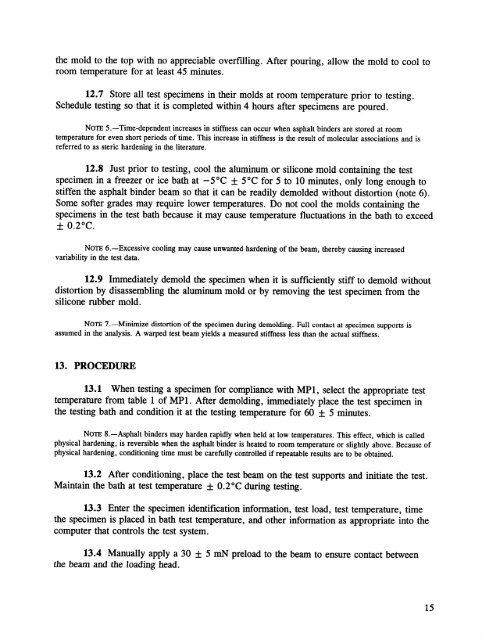Create successful ePaper yourself
Turn your PDF publications into a flip-book with our unique Google optimized e-Paper software.
the mold to the top with no appreciable overfilling. After pouring, allow the mold to cool to<br />
room temperature for at least 45 minutes.<br />
12.7 Store all test specimens in their molds at room temperature prior to testing.<br />
Schedule testing so that it is completed within 4 hours after specimens are poured.<br />
NOTE 5.--Time-dependent increases in stiffness can occur when asphalt binders are stored at room<br />
temperature for even short periods of time. This increase in stiffness is the result of molecular associations and is<br />
referred to as steric hardening in the literature.<br />
12.8 Just prior to testing, cool the aluminum or silicone mold containing the test<br />
specimen in a freezer or ice bath at -5°C + 5°C for 5 to 10 minutes, only long enough to<br />
stiffen the asphalt binder beam so that it can be readily demolded without distortion (note 6).<br />
Some softer grades may require lower temperatures. Do not cool the molds containing the<br />
specimens in the test bath because it may cause temperature fluctuations in the bath to exceed<br />
+ 0.2°C.<br />
NOTE6.--Excessive<br />
variability in the test data.<br />
cooling may cause unwanted hardening of the beam, thereby causing increased<br />
12.9 Immediately demold the specimen when it is sufficiently stiff to demold without<br />
distortion by disassembling the aluminum mold or by removing the test specimen from the<br />
silicone rubber mold.<br />
NOTE7.--Minimize distortion of the specimen during demolding. Full contact at specimen supports is<br />
assumed in the analysis. A warped test beam yields a measured stiffness less than the actual stiffness.<br />
13. PROCEDURE<br />
13.1 When testing a specimen for compliance with MP1, select the appropriate test<br />
temperature from table 1 of MP1. After demolding, immediately place the test specimen in<br />
the testing bath and condition it at the testing temperature for 60 + 5 minutes.<br />
NoTE 8.--Asphalt binders may harden rapidly when held at low temperatures. This effect, which is called<br />
physical hardening, is reversible when the asphalt binder is heated to room temperature or slightly above. Because of<br />
physical hardening, conditioning time must be carefully controlled if repeatable results are to be obtained.<br />
13.2 After conditioning, place the test beam on the test supports and initiate the test.<br />
Maintain the bath at test temperature + 0.2°C during testing.<br />
13.3 Enter the specimen identification information, test load, test temperature, time<br />
the specimen is placed in bath test temperature, and other information as appropriate into the<br />
computer that controls the test system.<br />
13.4 Manually apply a 30 + 5 mN preload to the beam to ensure contact between<br />
the beam and the loading head.<br />
15



